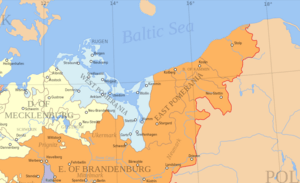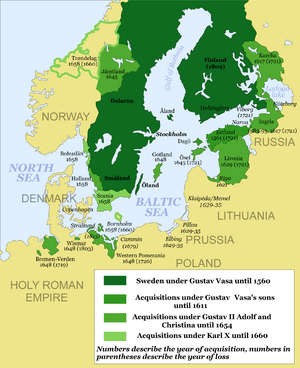Treaty of Stettin (1653) facts for kids

The Treaty of Stettin (also known as Grenzrezeß von Stettin) was an important agreement signed on May 4, 1653. It helped settle a big argument between two powerful groups: Brandenburg and Sweden. Both wanted control over a region called the Duchy of Pomerania. This argument happened after the local rulers of Pomerania, the House of Pomerania, died out during the Thirty Years' War.
Brandenburg believed it should inherit Pomerania because of an older agreement called the Treaty of Grimnitz (from 1529). Sweden, however, had taken control of parts of Pomerania during the war and based its claims on the Treaty of Stettin (1630).
Eventually, in 1648, the Peace of Westphalia ended the Thirty Years' War. This peace treaty decided that Pomerania would be split between Brandenburg and Sweden. The Treaty of Stettin then drew the exact border between their new territories. The western part became Swedish Pomerania, and the eastern part became Brandenburgian Pomerania.
Contents
Why the Treaty Was Needed

During the Thirty Years' War, Sweden had taken over the Duchy of Pomerania in 1630. The last duke of Pomerania, Bogislaw XIV, died in 1637. According to an older agreement called the Treaty of Grimnitz, Brandenburg was supposed to inherit his lands.
However, Sweden was still in control of Pomerania. This made it hard for Brandenburg to take over. The Peace of Westphalia in 1648 finally ended the war. It decided that Pomerania would be divided between Brandenburg and Sweden. In 1650, the Treaty of Nuremberg roughly outlined which areas would go to Sweden and which to Brandenburg.
What the Treaty Decided
The Treaty of Stettin in 1653 drew the exact border. It split the Duchy of Pomerania along a line that ran east of the Oder river. The areas west of this line, including the important city of Stettin, stayed with Sweden. This part became known as Swedish Pomerania.
The areas east of the line were given to Brandenburg. This part became Brandenburgian Pomerania. Even after Sweden left, they still received half of the customs money from the towns in Brandenburgian Pomerania.
After the treaty, the first local assembly (called a Landtag) in Brandenburgian Pomerania met in Stargard on July 19, 1653. By 1654, Sweden had completely moved out of Farther Pomerania.
Why This Treaty Was Important
The Treaty of Stettin gave Sweden control over the mouth of the Oder river. This was very important because Sweden already controlled the mouths of other major German rivers like the Weser and Elbe from the Peace of Westphalia. This treaty meant Sweden controlled the entry points of almost all major German rivers, except the Rhine. Swedish Pomerania became Sweden's largest territory inside Germany.
Later Border Changes
The border set by the Treaty of Stettin was changed a few times later. After the Scanian War, the border moved slightly west in the Treaty of Saint-Germain-en-Laye (1679). Then, after the Great Northern War, it moved much further west to the Peene and Peenestrom rivers in the Treaty of Stockholm (1720).
See also
 In Spanish: Tratado de Stettin (1653) para niños
In Spanish: Tratado de Stettin (1653) para niños
- Treaty of Stettin (1570)
- Treaty of Stettin (1630)
- Treaty of Stettin (1715)

